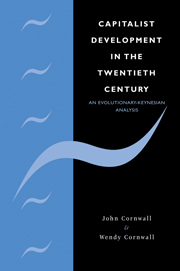Part I - Framework
Published online by Cambridge University Press: 22 September 2009
Summary
Introduction
This book examines macroeconomic development of the industrial nations during the past 100 years. Among the more notable features of capitalism's progress over this period have been alternating episodes of superior and poor economic performance. The main task of the book is to develop and apply a framework that explains these episodes and the causal linkages between them. The episodes to be analysed include the Great Depression, the golden age that followed World War II, and the current episode of high unemployment that began in the 1970s.
Underlying our explanation of these historical developments is an assumption about how developed capitalist economies function that contrasts sharply with the mainstream perception. Mainstream neoclassical thought sees a capitalist system as inherently self-regulating: given some exogenous disturbance, mechanisms operate to steer the economy back to its full employment growth path. In our view, capitalism is not self-regulating, nor is it doomed to self-destruct as some crude Marxian versions of capitalism's development claim. Instead, we see alternating episodes of superior and poor performance as a normal part of capitalist development, and trace them to structural changes. Those who would argue that capitalism is self-regulating (given the usual provisos) not only must believe that an invisible hand is rapidly and continuously clearing markets and providing the signals needed for ecient resource allocation; they must also believe that this same invisible hand is selecting the technologies and institutions from the evolving structural framework that guarantee markets work in this fashion.
- Type
- Chapter
- Information
- Capitalist Development in the Twentieth CenturyAn Evolutionary-Keynesian Analysis, pp. 1 - 6Publisher: Cambridge University PressPrint publication year: 2001

